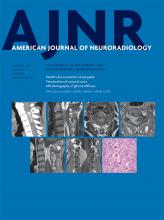Index by author
Miskin, N.P.
- LETTERYou have accessReply:S.K. Thakur, Y. Serulle, N.P. Miskin, H. Rusinek, J. Golomb and A.E. GeorgeAmerican Journal of Neuroradiology January 2018, 39 (1) E7; DOI: https://doi.org/10.3174/ajnr.A5525
Mohan, S.
- EDITOR'S CHOICEHead and Neck ImagingOpen AccessDynamic Contrast-Enhanced MRI–Derived Intracellular Water Lifetime (τi): A Prognostic Marker for Patients with Head and Neck Squamous Cell CarcinomasS. Chawla, L.A. Loevner, S.G. Kim, W.-T. Hwang, S. Wang, G. Verma, S. Mohan, V. LiVolsi, H. Quon and H. PoptaniAmerican Journal of Neuroradiology January 2018, 39 (1) 138-144; DOI: https://doi.org/10.3174/ajnr.A5440
The authors evaluated 60 patients with dynamic contrast-enhanced MR imaging before treatment. Median, mean intracellular water molecule lifetime, and volume transfer constant values from metastatic nodes were computed from each patient. Kaplan-Meier analyses were performed to associate mean intracellular water molecule lifetime and volume transfer constant and their combination with overall survival and beyond. Patients with high mean intracellular water molecule lifetime had overall survival significantly prolonged by 5 years compared with those with low mean intracellular water molecule lifetime. Patients with high mean intracellular water molecule lifetime had significantly longer overall survival at long-term duration than those with low mean intracellular water molecule lifetime. Volume transfer constant was a significant predictor for only the 5-year follow-up period. They conclude that a combined analysis of mean intracellular water molecule lifetime and volume transfer constant provided the best model to predict overall survival in patients with squamous cell carcinomas of the head and neck.
Montanera, W.J.
- InterventionalOpen AccessTime for a Time Window Extension: Insights from Late Presenters in the ESCAPE TrialJ.W. Evans, B.R. Graham, P. Pordeli, F.S. Al-Ajlan, R. Willinsky, W.J. Montanera, J.L. Rempel, A. Shuaib, P. Brennan, D. Williams, D. Roy, A.Y. Poppe, T.G. Jovin, T. Devlin, B.W. Baxter, T. Krings, F.L. Silver, D.F. Frei, C. Fanale, D. Tampieri, J. Teitelbaum, D. Iancu, J. Shankar, P.A. Barber, A.M. Demchuk, M. Goyal, M.D. Hill and B.K. Menon for the ESCAPE Trial InvestigatorsAmerican Journal of Neuroradiology January 2018, 39 (1) 102-106; DOI: https://doi.org/10.3174/ajnr.A5462
Montisci, R.
- Extracranial VascularYou have accessCT Attenuation Analysis of Carotid Intraplaque HemorrhageL. Saba, M. Francone, P.P. Bassareo, L. Lai, R. Sanfilippo, R. Montisci, J.S. Suri, C.N. De Cecco and G. FaaAmerican Journal of Neuroradiology January 2018, 39 (1) 131-137; DOI: https://doi.org/10.3174/ajnr.A5461
Mukai, H.
- Peripheral Nervous SystemYou have accessMR Imaging of the Superior Cervical Ganglion and Inferior Ganglion of the Vagus Nerve: Structures That Can Mimic Pathologic Retropharyngeal Lymph NodesH. Yokota, H. Mukai, S. Hattori, K. Yamada, Y. Anzai and T. UnoAmerican Journal of Neuroradiology January 2018, 39 (1) 170-176; DOI: https://doi.org/10.3174/ajnr.A5434
Mulholland, A.D.
- Adult BrainOpen AccessSpatial Correlation of Pathology and Perfusion Changes within the Cortex and White Matter in Multiple SclerosisA.D. Mulholland, R. Vitorino, S.-P. Hojjat, A.Y. Ma, L. Zhang, L. Lee, T.J. Carroll, C.G. Cantrell, C.R. Figley and R.I. AvivAmerican Journal of Neuroradiology January 2018, 39 (1) 91-96; DOI: https://doi.org/10.3174/ajnr.A5410
Naggara, O.
- FELLOWS' JOURNAL CLUBAdult BrainYou have accessDo Fluid-Attenuated Inversion Recovery Vascular Hyperintensities Represent Good Collaterals before Reperfusion Therapy?E. Mahdjoub, G. Turc, L. Legrand, J. Benzakoun, M. Edjlali, P. Seners, S. Charron, W. Ben Hassen, O. Naggara, J.-F. Meder, J.-L. Mas, J.-C. Baron and C. OppenheimAmerican Journal of Neuroradiology January 2018, 39 (1) 77-83; DOI: https://doi.org/10.3174/ajnr.A5431
The authors evaluated 244 consecutive patients eligible for reperfusion therapy with MCA stroke and pretreatment MR imaging with both FLAIR and PWI. The FLAIR vascular hyperintensity score was based on ASPECTS, ranging from 0 (no FLAIR vascular hyperintensity) to 7 (FLAIR vascular hyperintensities abutting all ASPECTS cortical areas). The hypoperfusion intensity ratio was defined as the ratio of the time-to-maximum >10-second over time-to-maximum >6-second lesion volumes. The FLAIR vascular hyperintensities were more extensive in patients with good collaterals than those with poor collaterals. The FLAIR vascular hyperintensity score was independently associated with good collaterals. They conclude that the ASPECTS assessment of FLAIR vascular hyperintensities could be used to rapidly identify patients more likely to benefit from reperfusion therapy.
Nicolaou, S.
- You have accessInfluences for Gender Disparity in Academic NeuroradiologyM. Ahmadi, K. Khurshid, P.C. Sanelli, S. Jalal, T. Chahal, A. Norbash, S. Nicolaou, M. Castillo and F. KhosaAmerican Journal of Neuroradiology January 2018, 39 (1) 18-23; DOI: https://doi.org/10.3174/ajnr.A5443
Norbash, A.
- You have accessInfluences for Gender Disparity in Academic NeuroradiologyM. Ahmadi, K. Khurshid, P.C. Sanelli, S. Jalal, T. Chahal, A. Norbash, S. Nicolaou, M. Castillo and F. KhosaAmerican Journal of Neuroradiology January 2018, 39 (1) 18-23; DOI: https://doi.org/10.3174/ajnr.A5443
O'connor, E.E.
- Adult BrainOpen AccessBrain Structural Changes following HIV Infection: Meta-AnalysisE.E. O'Connor, Timothy A. Zeffiro and Thomas A. ZeffiroAmerican Journal of Neuroradiology January 2018, 39 (1) 54-62; DOI: https://doi.org/10.3174/ajnr.A5432








